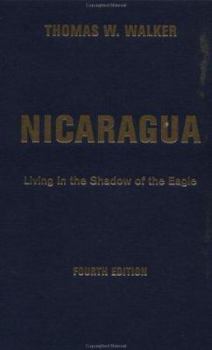Nicaragua: Living in the Shadow of the Eagle
Select Format
Select Condition 
Book Overview
This newly revised volume details Nicaragua's unique history, culture, economics, politics, and foreign relations. Its historical coverage considers the country's early and recent history, from... This description may be from another edition of this product.
Format:Paperback
Language:English
ISBN:0813338824
ISBN13:9780813338828
Release Date:January 2003
Publisher:Routledge
Length:238 Pages
Weight:0.85 lbs.
Dimensions:0.7" x 6.1" x 8.9"
Customer Reviews
3 ratings
Beautifully written
Published by Thriftbooks.com User , 14 years ago
I chose US intervention in Nicaragua as the main topic for a research paper in Latin American History. I bought this book hoping to learn the history of Nicaragua from Walker up to the present. It did not disappoint me and I found it interesting and beautifully written. When a book is well written, organized and engaging, you can follow the train of thought easily and read much faster. Although I consulted other books to write the paper, reading this one felt more like a past time and not work. You can tell the author has an emotional bond with the country, and this makes the book passionate and loving. I highly recommend it if you want to know more about Nicaragua without focusing too much on political rhetoric and meaningless figures.
Best concise history of Nicaragua
Published by Thriftbooks.com User , 17 years ago
This is written in a remarkably even-handed register when you consider the outrageous (imperial?) actions of the US over the years, regarding Nicaragua. I also found the explanation of dependent economies (where most of the effort goes into goods for export rather than goods for the common good!) very enlightening. It challenged my basic beliefs of what government does and should do for, with, and by its citizenry. If you want a concise history of Nicaragua that includes treatment of all the factions involved over the years, this is it! The author has appended an extensive bibliography of English-language sources and additional reading materials that appears very thorough and helpful to going deeper into this country.
Accessible, well written overview of Nicaragua's history and failed attempts to free itself from U.
Published by Thriftbooks.com User , 18 years ago
The leader of the U.S. trained and equipped National Guard Anastasio Somoza Garcia seized power in Nicaragua in 1936. He was an S.O.B., but he was our S.O.B. as Franklin Roosevelt immortally said privately in 1939 when Somoza visited him in Washington D.C. Somoza wanted the National Guard officers and enlisted men to enrich themselves in mafia-style rackets such as prostitution, according to Walker, so they would be dependent on him for their self-enrichment and would thus constitute a force immune from popular discontent. Somoza Garcia's son Luis succeeded him after his assassination in 1956. Luis set up a lot of bureaucracies supposedly devoted to social services and economic planning, but these were in reality mainly used as a vehicle to funnel U.S. aid money to the Somoza family and its cronies. Walker cites the particularly blatant case of how the government used U.S. aid money after an earthquake in December 1972 completely destroyed Managua. Anastasio Somoza Debayle Jr. took over as president from his brother in 1967. Anastasio Jr. reinstated a "state of siege" and sent the National Guard into the Countryside, where the (FSLN) Sandinistas were involved in stimulating peasant activism, after a December 1974 successful hostage taking operation by the Sandinistas. The Guard proceeded to rape and kill and pillage thousands. Many American Catholic clerical and lay workers witnessed these actions and the U.S. congress was moved to hold hearings. In 1977, President Carter suspended military aid to Somoza in order to force him to relax somewhat his censorship of the press, thinking that the U.S. could afford for Somoza to do so without the status quo in Nicaragua being disrupted. However, in early 1978, after increasing massacres of civilians in the tens of thousands by the National Guard Carter resumed economic and military aid to Somoza. The uprising had begun in early 1978 after the assassination of newspaper editor Pedro Joaquin Chamarro. The Carter administration, in conjunction with the Organization of American States, eventually tried to enforce its policy of "Somocismo sin Somoza".... Walker describes how the Carter administration refused to send arms to the Sandinistas and looked the other way as the military oligarchy in Honduras allowed remnants of the National Guard, helped by trainers from the Argentine neonazi military regime, to organize the force which would become the Contras. .... The Reaganites refused to sell arms to the Sandinistas, cut off all aid, and successfully pressured the French to end an arms deal with the Sandinistas in 1981. Increasingly, the Sandinistas were forced to rely on Soviet block arms. Walker notes that the rifles, AK-47's and tanks that the Nicaraguans received from the Soviet block were small in number and often old and decrepit. Clearly the Sandinistas were seeking military aid from the Soviet Block because the Reaganites had launched a full scale proxy terrorist war against them. The Contras





